Abstract
A manufacturing system is oriented towards higher production rate, quality, and reduced cost and time to make a product. Surface roughness is an index for determining the quality of machined products and is influenced by the cutting parameters. Surface roughness prediction in machining is being attempted with many methodologies, yet there is a need to develop robust, autonomous and accurate predictive system. This work proposes the application of two different hybrid intelligent techniques, adaptive neuro fuzzy inference system (ANFIS) and radial basis function neural network- fuzzy logic (RBFNN-FL) for the prediction of surface roughness in end milling. An experimental data set is obtained with speed, feed, depth of cut and vibration as input parameters and surface roughness as output parameter. The input-output data set is used for training and validation of the proposed techniques. After validation they are forwarded for the prediction of surface roughness. Both the hybrid techniques are found to be superior over their respective individual intelligent techniques in terms of computational speed and accuracy for the prediction of surface roughness.
Similar content being viewed by others
Explore related subjects
Discover the latest articles, news and stories from top researchers in related subjects.References
Liang SY, Hecker RL, Landers RG (2004) Machining process monitoring and control: The state of the art. ASME -J Manuf Sci Eng 126:297–310
Gadelmawla ES, Koura MM, Maksoud TMA, Elewa IM, Soliman HS (2002) Roughness parameters. J Mater Process Technol 123:133–145
Lee BY, Tarng YS (2001) Surface roughness inspection by computer vision in turning operations. Int J Mach Tools Manuf 41:1251–1263
Shinn-Ying Ho, Kuang-Chyi Lee, Chen SS, Ho SJ (2002) Accurate modeling and prediction of surface roughness by computer vision in turning operations using an adaptive neuro fuzzy inference system. Int J Mach Tools Manuf 42:1441–1446
Susic E, Grabec I (1995) Application of a neural network to the estimation of surface roughness from acoustic emission signals generated by friction process. Int J Mach Tools Manuf 35:1077–1086
Scot A.Coker, Shin YC (1996) In-Process control of surface roughness due to tool wear using a new ultrasonic system. Int J Mach Tools Manuf 36:411–422
Benardos PG, Vosniakos GC (2003) Predicting surface roughness in machining: a review. Int J Mach Tools Manuf 43:833–844
Goonatilake S, Sukhdev Khebbal (1995) Intelligent hybrid systems, Wiley
Yen John, Langari Reza (2003) Fuzzy Logic Intelligence Control and Information. Pearson Education, Delhi
Yue Jiao, Lei S, Pei ZJ, Lee ES (2004) Fuzzy Adaptive Networks in process modeling: surface roughness prediction for turning operations. Int J Mach Tools Manuf 44:1643–1651
Chen JC, Savage M (2001) A fuzzy-net based multi level in-Process surface roughness recognition system in milling operation. Int J Adv Manuf Technol 17:670–676
Lou SJ, Chen JC (1999) In-Process surface roughness recognition (ISSR) system in end-milling operation. Int J Adv Manuf Technol 15:200–209
Lin B, Zhu MZ, Yu SY,Zhu HT, Lin MX (2002) Study of synthesis identification in the cutting process with a fuzzy neural network. J Mater Process Technol 129:131–134
Jang JSR (1993) ANFIS: Adaptive-Network-Based Fuzzy Inference System. IEEE Trans Syst, Man, and Cybern 23:665–685
Dweiri F, Al-Jarrah M, Wedyan HA (2003) Fuzzy surface roughness modeling of CNC down milling of Alumic-79. J Mater Processing Technol 133:266–275
Mishra S, Hota PK, Mohanty PA (2003) Neuro Fuzzy based unified power flow controller for improvement of Transient stability performance. Institution of Engineers (India) Journal-Electrical 84:148–153
Lin SC, Chang MF (1998) A study on the effects of vibrations on the surface finish using a surface topography simulation model for turning. Int J Mach Tools Manuf 38:763–782
Huang Luke, Chen Joseph C (2001) A Multiple Regression Model to Predict In-process Surface Roughness in Turning Operation Via Accelerometer. J Ind Technol 17:1–8
Lou MS, Chen JC, Li CM (1999) Surface roughness prediction technique for CNC end milling. J Ind Technol 15:1–6
Feng CX, Wang X (2002) Development of empirical models for surface roughness prediction in finish turning. Int J Adv Manuf Technol 20:348–356
Eskandari H, Rezaee MR, Mohammadnia M (2004) Application of multiple regression and artificial neural network techniques to predict shear wave velocity from wireline log data for a carbonate reservoir in south west Iran, Article CSEG RECORDER, pp 41–48
Jang JSR, Sun CT, Eiji Mizutani (2004) Neuro-Fuzzy and soft computing a computational approach to learning and machine intelligence, Pearson Education
El-Mounayri H, Kishawy H, Briceno J (2004) Optimization of CNC ball endmilling: a neural network based model, Journal of Material Processing Technology. Article in Press
Briceno J, El-Mounayri H, Mukhopadhyay S (2002) Selecting an ANN for efficient modeling and accurate Simulation of the milling process. Int J Mach Tools Manuf 42:663–674
Kishore AV, Rao MVC (1997) A Novel Fuzzy Based Algorithm for Radial Basis Function Neural Network. IEEE:2007–2111
Jesuthanam CP, Kumanan S (2003) Inprocess Quality Control in Machining using Artificial Neural Network Proceedings of National conference on Advanced Machine Vision System for Societal Applications CEERI India pp 216–221
Author information
Authors and Affiliations
Corresponding author
Rights and permissions
About this article
Cite this article
Kumanan, S., Jesuthanam, C.P. & Ashok Kumar, R. Application of multiple regression and adaptive neuro fuzzy inference system for the prediction of surface roughness. Int J Adv Manuf Technol 35, 778–788 (2008). https://doi.org/10.1007/s00170-006-0755-4
Received:
Accepted:
Published:
Issue Date:
DOI: https://doi.org/10.1007/s00170-006-0755-4
